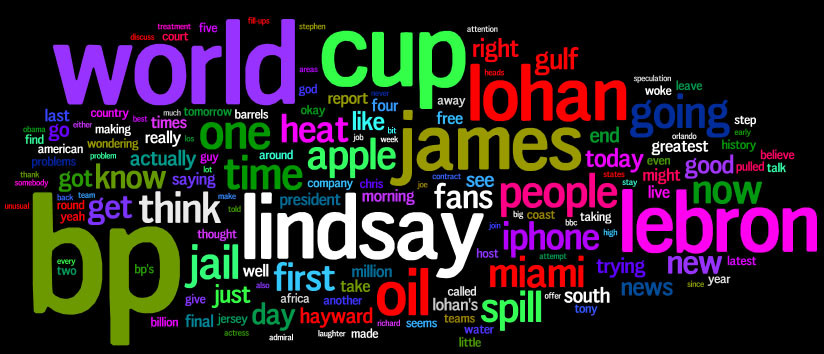The popular New York Times Blog, Media Decoder, pointed out a noteworthy trend this week. You may have speculated on this, owing to Apple's flashy press events and drawn out product releases, but a recently-published study from Pew Research Center's Project for Excellence in Journalism confirms it. (Hey, they use SnapStream to analyze TV, high fives!)
Media Snapshot 8/16 - 8/20
Rounding up a week in the news with our data collected at TV Trends, here's a cool word cloud that visually displays the nation's pulse. The words are proportionally sized to higher frequency of mention in the closed captioning data, showing the hottest and most prominent issues saturating the headlines. You see, Iraq, Brigade, Combat... Serious stuff.
Is Apple's iPad the supernova of tech-launch publicity?
We took it to our TV Trends analytics to investigate the uptick of buzz surrounding the iPad, which hits the market tomorrow. The forecast calls for an explosive spike in the media frenzy as users get their hands on experimenting with the highly anticipated Apple tablet. This Wednesday's episode of Modern Family indicates that it's going to be a full-on mob scene. Brilliant stroke of product placement, I might add.
Digital gravity pulls down DVD sales
Global DVD sales are projected to decline by 12% this year, compared to 9% in 2009, according to a recent report from Strategy Analytics in Home Media Magazine. Even with Blu-ray expected to rake in $6.5 billion in worldwide sales, it won’t be enough to sustain or regain the industry’s momentum.
Visualizing The State of the Union
As my team is in the field showing off our ability to search television for mentions of interest, we occasionally field questions about the variety of applications for the data. In general, SnapStream customers are able to search, clip and distribute content of interest from a single user interface. Using closed captioning, SnapStream brings a user directly to any mention of interest within a recorded broadcast. Occasionally, especially in a University or Public Relations setting, the topic turns to statistical analysis. While our solution does not currently offer a statistical engine, the data is easily exported for analysis.
Television news in 2009: Twitter, infidelity and more
(First time visitors: Welcome to SnapStream! We make TV search software used by organizations, like the Daily Show, to search inside TV shows. And it's not too expensive, starting at $2,000. Read on or learn more about our products.)
Analyzing trends on TV with SnapStream TV Trends
Today, we're launching SnapStream TV Trends (http://www.snapstream.com/tvtrends/), a tool that allows you to track trends on national television here in the United States.
SnapStream TV Search in Action: Plane Crash in the Hudson
I was deep in marketing-land on Thursday (also known as "writing a case study"), when I heard about the US Airways plane that crash-landed in the Hudson. I grew up in Houston, but lived in NYC for 5 years and moved back last year. I still have lots of friends there...so when I hear news like that coming out of NY I still feel like it's My News and it feels personal. Within minutes, my boss showed me that rescue picture that Janis Krums took from the ferry and posted to Twitter. I was really amazed by how quickly that picture got out. I watched as the number of "views" went from the dozens to the thousands. It was posted and cross-posted on lots of different blogs as the page views overloaded the Twitter server. Twitter is an amazing thing. I posted it to my Facebook page; I had friends in NY who learned of the plane crash from my Facebook post. Incredible.
TV coverage of the conventions (and the winner is... Hurricane Gustav!
Yesterday, I was wondering who got more national TV coverage during the Republican and the Democratic Conventions, so I decided to put the mostly-hidden graphing feature in SnapStream Enterprise through its paces.
What is SnapStream? There's an unlimited amount of video content out there: 24/7 news channels, breaking news events, sports, talk shows, awards galas, entertainment shows, and so much more.
SnapStream makes a real-time news and media search engine that makes it fast and easy to find the video moments that support our customers telling great stories.
Posts by Topic
- General TV Search (165)
- Technology Development (28)
- Support Corner (26)
- Television and Film Production (26)
- Social TV (24)
- Broadcast Monitoring (23)
- TV Trends (23)
- Tradeshows (23)
- news (23)
- Government (19)
- Release (19)
- Fun (16)
- Journalism (16)
- Politics (16)
- TV search (16)
- Education (14)
- Newsmedia (13)
- new product (13)
- updates (13)
- Entertainment (11)
- Video Clips (10)
- broadcast compliance (10)
- broadcast monitoring and compliance (10)
- social engagement (10)
- Twitter TV clips (8)
- Local TV stations (7)
- TV Monitoring/PR (7)
- Meet Team SnapStream (6)
- SnapStream News (6)
- Social in Sports (6)
- social sharing (6)
- livecut (5)
- City Government (4)
- International (4)
- Sports (4)
- media monitoring (4)
- snappytv (4)
- thought leadership (4)
- Addressable Advertising (3)
- CALM Act (3)
- Case Study (3)
- Context (3)
- Facebook TV clips (3)
- LKFS (3)
- Resources (3)
- SnapStream Cloud (3)
- SnapStream Enterprise (3)
- Streams (3)
- TV closed-captioning search (3)
- avoidance (3)
- clipping (3)
- ditigal (3)
- loudness compliance (3)
- misinformation (3)
- snappytv alternative (3)
- snappytv replacement (3)
- television monitoring (3)
- 8.3 (2)
- 8.5 (2)
- Advertising (2)
- How-to (2)
- Influencers (2)
- Jschool (2)
- News Satire (2)
- Pew Research (2)
- Radio Production (2)
- SnapStream (2)
- SnapStream Advanced (2)
- The Colbert Report (2)
- The Daily Show with Jon Stewart (2)
- Training (2)
- blog post (2)
- covid (2)
- covid-19 (2)
- election (2)
- live clipping (2)
- live video (2)
- loudness monitoring (2)
- media technology (2)
- trust (2)
- veracity (2)
- 8.1 (1)
- 8.2 (1)
- 9.1 (1)
- 9.2 (1)
- 9.3 (1)
- 9.4 (1)
- AEJMC (1)
- Barack Obama (1)
- Bloomberg TV (1)
- Fake News (1)
- H.264 (1)
- HLS (1)
- Hockey (1)
- Holiday (1)
- Houston tech (1)
- ISTE (1)
- Infotainment (1)
- International News Satire TV Shows (1)
- Lebron James (1)
- Libary (1)
- Local TV News (1)
- MVPD (1)
- MVPDs (1)
- Market Makers (1)
- Merging (1)
- Multi-viewer (1)
- NHL (1)
- Nancy Jennings (1)
- News Satire TV Shows in Other Countries (1)
- ONA21 (1)
- PIO (1)
- Playlists (1)
- Quality Assurance (1)
- RTMP (1)
- Reviewing Clips (1)
- STB (1)
- Satirical TV Shows (1)
- SnapStream 9.3 (1)
- SnapStream 9.4 (1)
- SnapStream 9.5 (1)
- SnapStream Interview (1)
- SnapStream Server (1)
- St. Louis Blues (1)
- Summer News (1)
- Super Bowl Commercials (1)
- Switch and Save (1)
- Uploading (1)
- Volicon (1)
- Webplayer (1)
- World Cup (1)
- Zoom (1)
- accessibility in broadcast (1)
- blogging (1)
- broadcast accessibility (1)
- broadcast tv accessibility (1)
- cable networks (1)
- closed captioning (1)
- closed captioning compliance (1)
- closed captions (1)
- content analysis (1)
- cto (1)
- customer appreciation (1)
- customers (1)
- debates (1)
- deep (1)
- deepfake (1)
- director of technology (1)
- edtech (1)
- encoder (1)
- explainer (1)
- fake (1)
- fan engagement (1)
- fire department (1)
- free server maintenance (1)
- innovation (1)
- live event (1)
- local tv (1)
- managed tv (1)
- media (1)
- monetization (1)
- online (1)
- podcast (1)
- police department (1)
- press release (1)
- public information officer (1)
- ratings (1)
- recording (1)
- remote work (1)
- set-top box (1)
- sharing (1)
- snapstream 9.6 (1)
- transmission engineering (1)
- tv alerts (1)
- tv networks (1)
- watchespn app (1)
- webinar (1)
- workspace (1)










